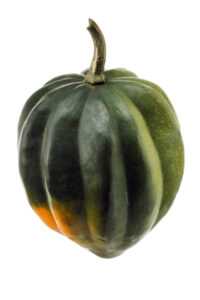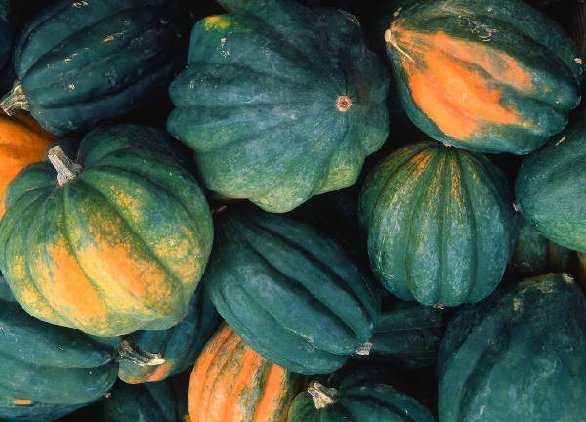From Little Acorns Grow…
Over the past weeks and earlier than usual, we have begun harvesting the first of our pumpkins. Here at Chubeza, when we say pumpkins we mean that slice of pumpkin you already got in your boxes, orange on the inside, light colored on the outside, as well as the smaller squashes – the Cinderella pumpkin (or Provence pumpkin) – orangish-brown on the outside; the elliptic spaghetti squash (orange, yellow or striped); the small green acorn squash; the orange kury squash that resembles a flattened droplet; the wonderful green kabocha; the light-orange-inside-and-outside mini Pam squash, and of course, the yummy creamy butternut, which was our pioneer squash this year. Last week, we even began harvesting the delectable squashes.
Interestingly, the bigger and smaller pumpkins (also known as winter squash), as well as summer squash, among them the zucchini, belong to the same botanical category, and even the same species. The differentiation between squash and pumpkins is artificial, having to do with the stage they are picked and how they are used. All varieties are seeded (in an open field, in their natural season) from the end of winter/beginning of springtime, and they all grow from spring to summer.
However, we pick the “summer squash” early, before they ripen, when their shell is thin and their seeds are not developed, sometimes as early as 40 days from seeding. Since we pick the fruits off the plant before it had time to produce fertilized seeds, the plant makes additional attempts, yielding more and more seed-bearing fruit in order to fulfill its aim in plant-life (and animal-life): to spread its genes. Thus we are granted a long harvest season from a plant that just keeps on yielding. These squash do not keep for long, which is why in the past they were only eaten during their natural season, summertime, hence their name. Today, squash are also grown in wintertime in hothouses, so they aren’t really seasonal.
Pumpkins (large and small), however, are picked as they ripen and mature, when their shell is thick and hard and their seeds are quite large. Since we wait till the complete ripening, they are harvested three to five months from seeding day. Our Tripolitanian pumpkin is large, and often requires a wait of six months. In places where winter is long and hard and pumpkins are seeded in the middle of springtime, they only arrive at a full ripening at the end of summer. Their hard shell allows them to keep nicely, sometimes up to six months (depending on the variety), enabling them to be eaten in wintertime. This presents a particularly significant advantage in the pumpkin’s ancestral home of North America in those areas where it is too cold to grow food during the winter. Pumpkins were easily stored in warehouses, offering sweetness and a summery zest to the cold wintery days.
We will begin the pumpkin parade by introducing you to the wonderful acorn squash, which most of you have already met, and all of you will have the privilege of getting to know over the next few weeks.
The acorn squash originates in Mexico and the U.S. where the Native Americans cultivated earlier species. The dark green type which we grow, which Americans insist is heart shaped (I think pinecone- shaped would be a more accurate description) was introduced in 1913 by the Iowa Seed Company, where it arrived from Denmark or North Dakota (there is a controversy about this). It was received enthusiastically, thanks to its excellent taste and also because of its small size and thin shell, a source of relief for those battling the huge, hard pumpkins. In the U.S., and especially for those dining alone, it made a good serving-for-one as well as a great stuffed vegetable.
Over the past few years we have been growing small roundish acorn squashes, from the Israeli “Origin Seeds” company. Last year, they suffered a decline in their yield, and could not produce enough seeds to market this year, which is why we now grew a different variety that yielded much larger acorn squashes, more suited for a family and more “pointy.” The plants also yielded early, which is why this is our pioneer pumpkin this year. We know it is time for harvest when the green shell shows a yellow spot, usually elongated. This generally happens parallel to the collapse of the acorn bushes from viruses and exhaustion. However, this year, due to the early ripening, the yellow spot appeared and the bushes remained nice and green. To make sure the fruit was ripe, we took some home to examine, and one exciting attempt made it clear that the time had come: the fruit was sweet and yummy.
The acorn squash really does taste great. Its skin is less moist as the regular squash, and it has a sweet and nutty taste, which gave it the brilliant name “acorn squash.” Due to its sweetness, it goes very well with salty flavors – olive oil, salt, pepper and herbs, as well as sweet flavors – a gentle brush of honey or date honey. The cracks lining the fruit make it somewhat difficult to peel, but the good news is that you really do not have to! It tastes great in its shell. And if you still need to eat this squash shell-less, remove it only upon baking or cooking when it’s so much easier to do so.
The acorn contains more vitamin C and calcium than other squash, and less vitamin A. If you treat it kindly, it will keep for a few months, but its flavor will ebb. So let it decorate your countertops for a week or two, and then send it straight to the oven and onto your plates!
Make this week bring good news and comfort,
Alon, Bat Ami, Dror, Maya and the Chubeza team
WHAT’S IN THIS WEEK’S BOXES?
Monday: New Zealand spinach, potatoes, lettuce, tomatoes, beets, acorn squash, sage/thyme, fakus/cucumbers, parsley/dill, eggplant/beans/artichoke, zucchini.
Large box, in addition: Parsley root, scallions/leeks/chives, watermelon
Wednesday:
New Zealand spinach, red potatoes, lettuce, tomatoes, acorn squash, sage/thyme, fakus/cucumbers, parsley/cilantro, zucchini, scallions/chives,small boxes only-eggplant
Large box, in addition: Parsley root, watermelon, beans, beets/cherry tomatoes
_______________________
Recipes:
Southwestern stuffed acorn squash
Roasted Acorn Squash with Chile-Lime Vinaigrette
Acorn squash flowers and Acorn Squash Stuffed with Chestnuts and Mushrooms (scroll down)
Three delicious acorn squash recipes by Limor Laniado Tiroche:


